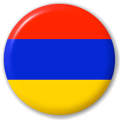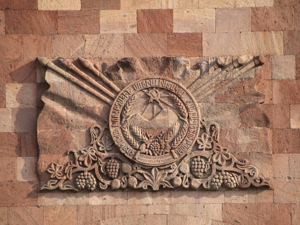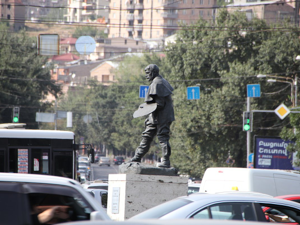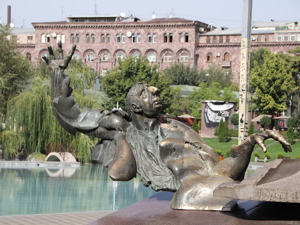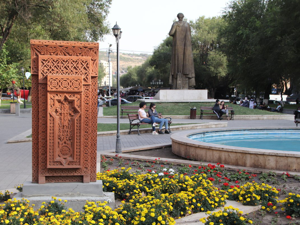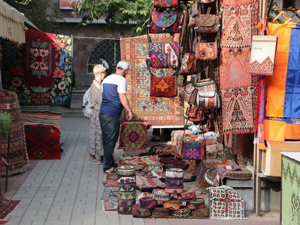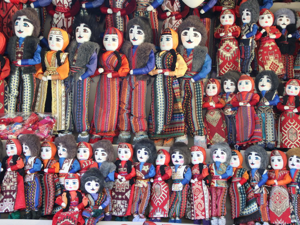Kyrgyzstan and Tajikistan 2018
Kyrgyzstan and Tajikistan 2018

Caucasus 2018
Yerevan has an official population of 1.2 million people, but the real figure os almost certainly closer to 1.5 million. That makes it the smallest of the three capital cities I’m visiting in the Caucasus as both Tbilisi and Baku are a little larger. Unlike Baku and Tbilisi, Yerevan’s charm doesn't immediately jump out as being obvious. Much of the city comprises prefabricated buildings and Soviet-era public buildings, many built after the city’s devastating earthquake in 1988 destroyed large parts of the city (as well as killing between 25,000 and 50,000 people and injuring a further 130,000). You can’t say that the city is just grey concrete because most of the buildings, including the brutalist Soviet housing blocks, are built using pink-coloured locally quarried rose tuff. Despite its often generic Soviet facades, some lovely public spaces and buildings can be found with a bit of scratching beneath the surface, and it is clear that efforts are being made to revitalise the city despite very limited resources.
We began our travels today at the relatively later time of 9:30am by heading 20 kilometres west from Yerevan to Echmiadzin. Known as the Vatican of the Armenian Apostolic Church, Echmiadzin is (like the Vatican in Rome) a city within a city, in this case within the town of Vagharshapat, although of course Echmiadzin does have separate sovereignty as a sovereign state. Legend says that when Armenia adopted Christianity in 301, St Gregory the Illuminator had a vision in which Jesus returned to earth holding a golden hammer, which he struck into the ground and commanded that a church building be erected in that spot.
That place was Echmiadzin, and so from 301 to 303, Armenia’s (and the world’s) first Christian church building was constructed on the site. That first building was a simple square building with a flat roof, and it was replaced by a larger building in the shape (in plan view) of a cross that was built in 480. That is the building which now, with some significant extensions dating from 1441, is the Mother Cathedral of the Armenian Church (Mayr Tachar).
Echmiadzin comprises many other buildings besides the Mother Cathedral, as well as spacious gardens, although the cathedral is the largest building in the complex. Unfortunately, the cathedral began major renovations three years ago that are still underway (with no stated finishing date), so much of the cathedral’s exterior had scaffolding around it, and most of the interior was covered in white plastic sheeting. However, the cathedral’s museum was open and gave a fascinating insight into the Armenian church’s history and practices, while a white marble altar marking the precise spot where the visionary golden hammer struck the ground was open to view.
After an hour and a half exploring Echmiadzin, we returned to Yerevan to visit one of the city’s most poignant sites, the memorial and museum to the Armenian genocide that was conducted by Turkey in the sunset days of the Ottoman Empire in 1915. Initiated on 24th April 1915, the genocide is still denied by Turkey and its allies (such as the United States). The genocide of Armenians living in what was then the eastern part of the Ottoman Empire was a deliberate attempt to unite Muslims in Turkey to support the war effort on the side of Germany in Wold War I by attempting to murder as many Christian Armenians as possible. Within a short period of time, 1.5 million Armenians were killed by Turkish authorities.
We began by visiting a moving memorial to the genocide that was erected by the Soviet government in 1967 to mark the 50th anniversary of the genocide in 1965. Located at the end of a 100 metre long wall that lists the names of massacred communities, the memorial comprises a circle of twelve inwardly leaning basalt slabs that guard an eternal flame. A little way away from the circle is a 40-metre high thin split spire, and at the other end of the wall, a forest of trees is emerging as visiting world leaders show their respect by planting a tree.
After visiting the memorial, we then spent half an hour exploring the museum, which tells the story of the genocide in moving detail with impressive evidence such as photographs, explanations and documents. How genocide denial can persist given the evidence is puzzling, and can only be explained in terms of manipulative political allegiances and misplaced loyalties.
Rejoining the bus, we drove into central Yerevan to the foot of the Cascade. Probably the most elegant renewed part of Yerevan, the Cascade is a flight of 2,700 steps and flower beds that leads up a hill away from the city centre. We were given an hour and a half for lunch, so I spent the first half hour of that ascending the Cascade to get what is regarded as the best view over the city of Yerevan. Some cities look great when seen from an elevated panoramic viewpoint, but Yerevan isn’t one of them, and the view highlighted the bland, box-like buildings that dominate the skyline.
It shouldn’t have been like this. At the foot of the Cascade, there is a statue of the Armenian architect and town planner, Alexander Tamanyan, who laid out an impressive plan for Yerevan in the early Soviet period with wide avenues, separate zones for administrative and cultural buildings, green circles of parkland and an overall rate of 30% of the city’s area devoted to parks and open spaces. A sculptured simplified model of his city design formed part of Tamanyan’s monument, but it is really of academic interest today as only a few pale reflections of his vision can be seen in present-day Yerevan.
I joined some others in the group at an Armenian restaurant in retro-Soviet décor that even included the front half of a ZAZ Zaporozhets 968M rear-engined minicar from the early 1980s protruding the interior wall, and an early model Volga sedan from the 1950s in the street outside.
When we regrouped at 3:00pm, we began a walking tour through the streets of central Yerevan. In one of the parks outside the State Conservatory of Music, we saw a statue of Soghomon Soghomonian, more commonly known simply as Komitas, who was an Armenian priest who recorded 3,000 pieces of traditional Armenian music between 1895 and 1904. This proved to be highly significant as the villages where he recorded the music were wiped out during the Genocide of 1915, and without his recording all their music would have been lost. As things turned out, only 800 of his recordings survive, but it is nonetheless a valuable contribution in preserving Armenia’s musical heritage. He later went insane and died in a psychiatric hospital in Paris in 1935.
Another interesting sculpture was in an inaccessible roundabout in front of the huge Yerevan Opera Theatre. A ridiculously tiny sculpture for such a large roundabout, the sculpture was an original by Rodin, given to Yerevan by the French, showing the painter Jules Bastien-Lepage. It looked quite out of place in its incongruous location, and apparently the only time local people have had a chance to see it properly was in 2008 when public demonstrations closed the street and people could get close enough to the statue.
Our walk continued past some good examples of architecture from various periods of Yerevan’s history, and by 4:00pm we had walked south along Abovyan Street to reach Republic Square (formerly Lenin Square). This was a lovely large open area with fountains in the middle and an array of five of Yerevan’s most impressive buildings around it: the State Museum of Armenian History (which includes the National Art Gallery), the Marriott Hotel, Government House, and the Ministries of Foreign Affairs and Transport and Communications.
The organised walking tour concluded at Republic Square, so like several others, I decided to use the opportunity to have a look inside the square’s most impressive (and newest) building, the State Museum of Armenian History. The display spread over two floors, and traced Armenia’s complex history from prehistoric days right through to independence. The most impressive displays related to Armenia’s ancient history, and for some strange reason, the English captions on the exhibits seemed to die some time around the 13th century.
I made my way back to the hotel along a strip of parkland that contained some wonderful examples of traditional Armenian vertical cross stones (khachkars) as well as Yerevan’s flea market and souvenir stalls, which were far more extensive and ‘up-market’ that the array of goods being sold on the footpath of the Dry Bridge in Tbilisi.
One member of the group had their birthday today, so to celebrate we all came to together at 7:00pm to celebrate with Armenian champagne and local specialty chocolates. It was good to finish this enjoyable day over good conversation and company.

Day 12
Yerevan and Echmiadzin
Friday
14 September 2018
